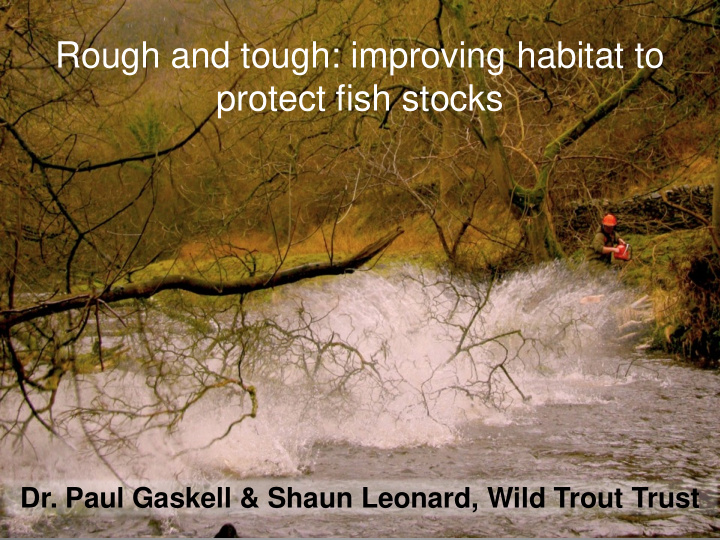



Rough and tough: improving habitat to protect fish stocks Dr. Paul Gaskell & Shaun Leonard, Wild Trout Trust
Hudson Bay Company pelt records: the textbook classic predator/prey cycling example Krebs, C.J., R. Boonstra, S. Boutin et al ., What drives the snowshoe hare cycle in Canada's Yukon, in Wildlife 2001: Populations, D.R. McCullough and R.H. Barrett, Editors. 1992, Elsevier: New York. p. 886-896.
Predator/Prey interactions If nice neat cycles are rare: What do we know about habitat influence on predator/prey dynamics ?
Old school pure ecology: mites, oranges and rubber balls ① Huffaker study: predatory + herbivorous mites in constructed ‘arenas’ to study the effect of habitat complexity ② ‘Arenas’ included: – Oranges (mite food) – Oranges + rubber balls etc (food + much more complex physical environment and greater prey refuge) Huffaker, C.B., Experimental studies on predation: dispersion factors and predator - prey oscillations. Hilgardia, 1958. 27: p. 343-383.
So, might things be similar in fish populations? Bring out the Bass!
Bass predation on Bluegills Various artificial weed densities Gotceitas, V. & Colgan, P. (1989) Predator Foraging Success and Habitat Complexity - Quantitative Test of the Threshold Hypothesis. Oecologia, 80(2), 158-66.
Predator success decreases as plant density increases Bluegills choose denser cover
Refuge work here…
Russell et al. (2008) UK cormorant study • Experimental ponds + artificial refuges Control ponds with no artificial refuges • In the refuge ponds 79% less fish lost in refuge ponds 67% less fish eaten directly by cormorants 77% fewer visits to refuge ponds Cormorants c 35% less efficient Russell, I., et al., Reducing fish losses to cormorants using artificial fish refuges: an experimental study. Fisheries Management and Ecology, 2008. 15(3): p. 189-198.
Classic predictions of habitat complexity versus predator/prey interactions ① In ‘simple’ habitats, predators efficient and systems unstable ① habitat complexity predator efficiency and may tend to stabilize the interaction (lower risk of prey extinction) e.g. Crowder, L.B. & Cooper, W.E. (1982) Habitat Structural Complexity and the Interaction between Bluegills and Their Prey. Ecology, 63(6), 1802-13.
How to make this stuff relevant in wild streams?
To start: what’s good and bad habitat?
How does WTT work increase habitat complexity?
How does WTT work increase habitat complexity?
How does WTT work increase habitat complexity?
Would we expect this to protect against bird predation? • Optimal foraging theory… A predator should leave a patch when its rate of food intake in the patch drops to the average rate for the habitat as a whole • So, increasing search time and reducing capture efficiency by increasing habitat complexity should make predators give up on a patch sooner e.g. Pyke, G.H., Pulliam, H.R. & Charnov, E.L. (1977) Optimal Foraging - Selective Review of Theory and Tests. Quarterly Review of Biology, 52(2), 137-54.
Wye & Usk Foundation Work 22.8km of river bank completed in first year
Any evidence it works? Nant Bran Salmon Abundance Percentage change in numbers relative to reference site Fry Parr Habitat works carried out
Habitat Work – Problems not Solutions? • Land Drainage Consent? • How to secure LWD/CWD? • What if the stuff does break away? • Does it actually work? • Is it fish aggregation or genuine increased numbers? • Displaces not removes the issue? • Not good for some species e.g. grayling? • River users not happy – perception of ‘rubbish’ in the river!
Best Shot? • Make and keep your river rough • Use LWD and CWD • Fish live in trees!
Photo: C. Rangeley-Wilson
Recommend
More recommend